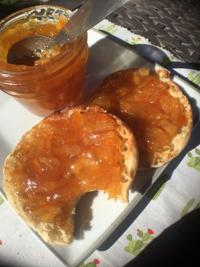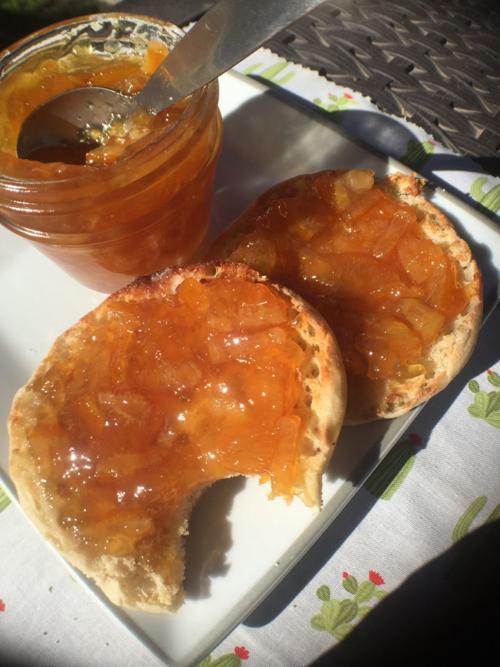I’m continuing my Meyer lemon love this week with a marmalade recipe that I hope you’ll enjoy. Their season is so brief that I want to take advantage of them in every possible way.
Making fruit preserves is a meditative process. This one features a lot of unavoidable knife work, and by the time the lemons are cut into thin slices, your kitchen will be filled with Meyer lemons’ lovely floral fragrance and the tips of your fingers will be as pruney as if you’ve soaked in a long bath.
So sharpen your sharpest knife, give it a good steeling and get ready to enjoy the painstaking process. The result is worth it, I promise. It took longer for me to cut the little pieces than it did for the marmalade to cook to doneness, but what’s the hurry? Sometimes in life, the trip has more value than the destination.
I found it helpful to have a roll of paper towels handy as I cut up the thin little pieces. Wiping down the cutting board after each lemon saved me from lemon juice all over the counter. A bonus is that my olive wood cutting board now smells sweet. If you’d rather not use paper towels, you could set your cutting board onto a rimmed baking sheet to recover some of that escaped juice (add it to the saucepan when you begin cooking the mixture).
There are many faster marmalade recipes out in the world. Some rely on bottled, powdered or pouched pectin. I generally avoid that product because it’s easy to achieve a kind of leathery result when it’s used. This very traditional marmalade uses only the pectin found in the lemons’ peels and pith for its setting power. Combined with sugar syrup’s magical ability to break down the lemon segments and soften the tough peel, it’s the kind of simple-ingredients-carefully prepared cooking that I prefer. With just three ingredients, this recipe is within anyone’s reach.
An unusual step in this recipe is the blanching of the little pieces. Doing so helps soften the bitterness of the pith, so don’t skip it lest your marmalade be too bitter. And do take the time to allow the mixture to cook slowly — you don’t need to stand over it as it cooks, but do check on it frequently to be sure it’s not scorching or sticking, especially near the end of cooking.
This marmalade, like any, is excellent on toast or an English muffin in the morning. But the addition of rosemary means that it’s also a terrific baste for baked chicken or fish, the rosemary’s piney flavor lending an herbaceous oomph to the already delicious stuff. I have also stirred dollops of this marmalade into a mixture of sour and whipped cream for an enviable light dessert.
Meyer lemon-rosemary marmalade
Makes 1 1/2 to 2 cups
This recipe is based on one from Matthew Scialabba and Melissa Pellegrino’s marvelous cookbook, “The Southern Italian Farmer’s Table,” which offers recipes from more than 30 Italian agriturismi farms, working family farms that host tourists. I have recast the instructions slightly and added the rosemary. I have also provided canning instructions if, like me, you’d like to send jars to faraway friends.
Ingredients
7 to 8 Meyer lemons, ideally organic
1 cup cold water
2 cups granulated sugar
2 to 4 long sprigs of fresh rosemary
Preparation
Scrub the lemons and trim both stem and blossom ends with thin slices. Cut 4 lemons into quarters from top to bottom, and cut each quarter lengthwise again, to end with 8 wedges. Remove the seeds, and cut each wedge crosswise into thin slices, 1/8 to 1/4 inch wide. Pile the slices into a small saucepan.
Cover the sliced lemons with water. Over medium-high heat, bring to a boil. Cook 2 to 3 minutes, to remove bitterness. Drain, and set aside. Rinse the saucepan and set aside to use later.
Meanwhile, use a sharp paring knife to trim the peel and pith from 2 of the remaining lemons. Holding the lemons over a small bowl, cut between the membranes to release each segment, removing seeds as you come to them. Allow the segments and juice to fall into the bowl. Discard membranes, peels and pith.
Juice the remaining lemon into the bowl. You will have 1/4 to 1/2 cup juice. Discard juiced lemon halves.
In the rinsed saucepan, combine 1 cup cold water, 2 cups granulated sugar, lemon juice. Over medium-high heat, bring mixture to a boil, stirring until the sugar dissolves, 2 to 3 minutes. Add the lemon segments and sliced lemon pieces, and rosemary; return the mixture to a boil. Reduce the heat to low, skim any foam from the surface and simmer gently until the mixture breaks down and thickens, 40 to 60 minutes, checking frequently to prevent scorching or overcooking. Remove errant seeds as you discover them.
While the mixture simmers, place a small plate into the freezer. To test for doneness, place a spoon of the simmering mixture onto the chilled plate and let it cool for a few moments. Push your finger through the marmalade. If the mark remains, the marmalade is ready; if it doesn’t, cook the mixture for a few minutes and retest.
Remove the mixture from heat and allow to cool. Remove the rosemary sprigs, as well as any rosemary leaves that may have detached during cooking. Once fully cooled, the marmalade should be covered and will hold in the refrigerator for up to 2 weeks.
If you wish to can the marmalade, portion the still-hot marmalade into sterile half-pint or pint canning jars. Cover with sterilized lids, add rings and tighten finger-tight. Place filled jars into a boiling water bath with water to cover by two inches. Process for 10 minutes for both half-pints and pints.





